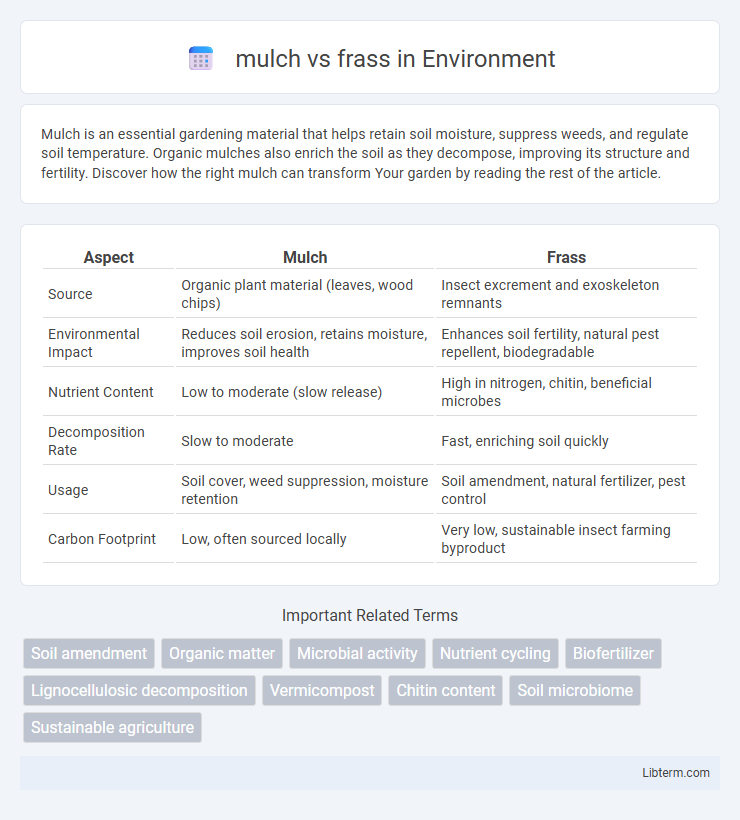Mulch is an essential gardening material that helps retain soil moisture, suppress weeds, and regulate soil temperature. Organic mulches also enrich the soil as they decompose, improving its structure and fertility. Discover how the right mulch can transform Your garden by reading the rest of the article.
Table of Comparison
| Aspect | Mulch | Frass |
|---|---|---|
| Source | Organic plant material (leaves, wood chips) | Insect excrement and exoskeleton remnants |
| Environmental Impact | Reduces soil erosion, retains moisture, improves soil health | Enhances soil fertility, natural pest repellent, biodegradable |
| Nutrient Content | Low to moderate (slow release) | High in nitrogen, chitin, beneficial microbes |
| Decomposition Rate | Slow to moderate | Fast, enriching soil quickly |
| Usage | Soil cover, weed suppression, moisture retention | Soil amendment, natural fertilizer, pest control |
| Carbon Footprint | Low, often sourced locally | Very low, sustainable insect farming byproduct |
Understanding Mulch and Frass: Key Differences
Mulch primarily consists of organic or inorganic materials spread over soil to retain moisture, regulate temperature, and suppress weeds, while frass is the biodegradable excrement of insects, rich in nitrogen and acts as a natural fertilizer enhancing soil fertility. Mulch decomposes slowly, improving soil structure and preventing erosion, whereas frass breaks down quickly, providing immediate nutrient release and beneficial microbial activity. Understanding these differences helps optimize garden soil health by selecting mulch for protection and frass for nutrient enrichment.
Composition and Sources of Mulch and Frass
Mulch primarily consists of organic materials such as wood chips, straw, leaves, and composted plant matter sourced from forestry, agriculture, and gardening byproducts, contributing to soil moisture retention and weed suppression. Frass, by contrast, is insect excrement, mainly produced by larvae like caterpillars and beetles, containing chitin, nitrogen, and beneficial microorganisms that enhance soil fertility and stimulate plant growth. The distinct compositions influence their applications, with mulch serving mainly as a protective soil layer, and frass acting as an organic fertilizer derived from insect digestion processes.
Nutritional Benefits for Plants
Mulch primarily improves soil moisture retention and temperature regulation but offers limited direct nutritional benefits for plants. Frass, composed of insect larvae excrement, is rich in nitrogen, chitin, and beneficial microorganisms that enhance soil fertility and stimulate plant growth. Its high nutrient content promotes improved root development and disease resistance compared to traditional mulch.
Impact on Soil Health and Microbiology
Mulch improves soil health by retaining moisture, reducing erosion, and fostering beneficial microbial activity through organic matter decomposition. Frass, rich in chitin and nutrients, acts as a natural fertilizer that enhances soil microbiology by stimulating beneficial bacteria and fungi essential for nutrient cycling. Both amendments support soil structure and fertility, but frass specifically boosts microbial populations linked to plant growth and disease resistance.
Water Retention and Moisture Control
Mulch improves water retention by creating a protective layer over soil, reducing evaporation and maintaining consistent moisture levels essential for plant health. Frass, rich in chitin and nutrients, enhances soil structure and microbial activity, indirectly promoting moisture retention and better water absorption. Optimal moisture control is achieved by combining mulch's physical barrier properties with frass's biological soil enrichment.
Application Methods: How to Use Mulch and Frass
Mulch is typically spread in a 2-4 inch layer around plants to retain soil moisture, regulate temperature, and suppress weeds, while leaving gaps near stems to prevent rot. Frass, insect excrement and exoskeleton fragments, is usually applied as a fine top dressing or mixed into the soil to improve microbial activity and provide a slow-release nutrient source. Both materials benefit from periodic reapplication depending on environmental conditions and plant growth cycles.
Environmental Sustainability Considerations
Mulch, made from organic materials like wood chips or leaves, enhances soil moisture retention and reduces erosion while decomposing slowly to enrich soil nutrients, contributing to sustainable landscaping practices. Frass, an insect byproduct rich in chitin and beneficial microbes, promotes plant growth and pest resistance with a lower environmental footprint due to its natural origin and rapid biodegradability. Both mulch and frass reduce reliance on chemical fertilizers and pesticides, supporting eco-friendly gardening and carbon sequestration efforts.
Cost and Accessibility Comparison
Mulch generally costs less and is widely accessible at garden centers, home improvement stores, and nurseries, making it an affordable option for soil moisture retention and weed control. Frass, a byproduct of insect larvae, tends to be more expensive due to its niche production and specialized sourcing, but offers enhanced organic fertilization benefits. Home gardeners often find mulch more readily available and budget-friendly, while frass may require ordering online or from specialty suppliers.
Common Myths and Misconceptions
Mulch is often mistaken as purely decorative material when it also regulates soil temperature and moisture, whereas frass is commonly misunderstood as waste despite being a nutrient-rich insect excrement beneficial for plant growth. Many believe mulch decomposes quickly, but high-quality wood chip mulch can last several months, unlike frass, which typically integrates into soil more rapidly due to its organic composition. It is a misconception that frass attracts pests; in reality, it can promote beneficial microbial activity that suppresses harmful insects.
Choosing the Right Option for Your Garden
Mulch improves soil moisture retention and temperature regulation by forming a protective layer over garden beds, while frass, an insect-based organic fertilizer, enriches soil with nitrogen, chitin, and beneficial microbes that promote plant growth and pest resistance. Choose mulch when prioritizing weed suppression and moisture conservation, ideal for established plants and trees, whereas frass is best used as a nutrient-rich supplement to enhance soil fertility and boost plant immune systems. Integrating both can optimize garden health by combining physical soil protection with biological nourishment.
mulch Infographic

 libterm.com
libterm.com